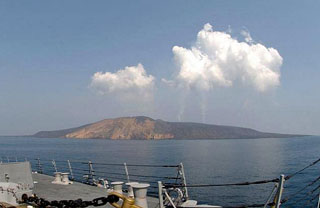Report on Jebel at Tair (Yemen) — 28 November-4 December 2007
Smithsonian Institution / US Geological Survey
Weekly Volcanic Activity Report, 28 November-4 December 2007
Managing Editor: Sally Sennert.
Please cite this report as:
Global Volcanism Program, 2007. Report on Jebel at Tair (Yemen) (Sennert, S, ed.). Weekly Volcanic Activity Report, 28 November-4 December 2007. Smithsonian Institution and US Geological Survey.
Jebel at Tair
Yemen
15.55°N, 41.83°E; summit elev. 244 m
All times are local (unless otherwise noted)
Since the beginning of an eruption of Jebel at Tair on 30 September, the MODIS satellite detected thermal anomalies over the island every day through 4 December. According to a news article, an eruption took place on 4 December and lava flows intermittently occurred since 30 September.
Geological Summary. The basaltic Jebel at Tair volcano rises from 1,200 m depth in the south-central Red Sea, forming an oval-shaped island about 3 km long. It is the northernmost known Holocene volcano in the Red Sea and lies SW of the Farisan Islands. Youthful basaltic pahoehoe lava flows from the steep-sided central vent, Jebel Duchan, cover most of the island, draping a circular cliff cut by wave erosion of an older edifice and extending beyond it to form a flat coastal plain. Pyroclastic cones are located along the NW and S coasts, and fumarolic activity occurs from two uneroded scoria cones at the summit. Radial fissures extend from the summit, some of which were the sources of lava flows. Explosive eruptions were reported in the 18th and 19th centuries, prior to an eruption in 2007-2008.
Sources: Hawai'i Institute of Geophysics and Planetology (HIGP) Thermal Alerts Team, IRIN News

